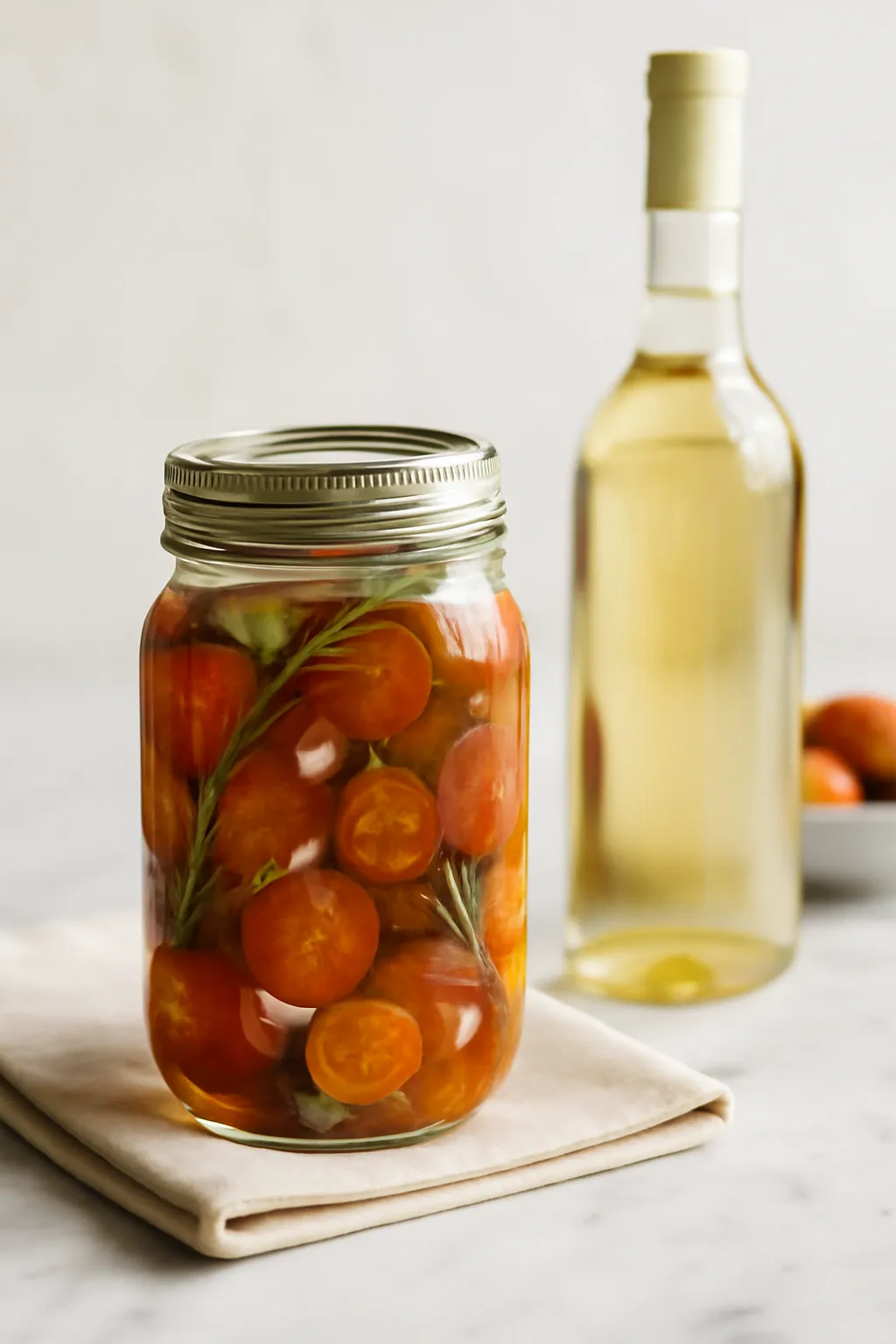Ever thought pickles could taste elegant? What if the key ingredient wasn’t vinegar—but white wine? Dive into the fascinating world of Charmy vegetables, pickled in white wine, and uncover how this fusion of flavor, tradition, and freshness can elevate your culinary creativity.
White wine
When people think of white wine, they often imagine a chilled glass paired with seafood or enjoyed on a warm afternoon. But did you know that white wine can be a stunning foundation for creating refined pickles like Charmy vegetables?
What is white wine really made of?
At its core, white wine is produced from green or yellowish grapes—like Chardonnay, Sauvignon Blanc, or Riesling. Unlike red wine, white wine is typically fermented without grape skins, which gives it a lighter body and fresher profile. These characteristics make it a perfect partner in pickling, especially for delicate vegetables like cherry tomatoes.
White wine’s acidity and subtle sweetness bring out the full potential of Charmy-style vegetable pickles. Unlike sharp vinegar pickles, those made with white wine develop a more aromatic and rounded flavor, often infused with herbs like rosemary or thyme, garlic, and even citrus peels.
Why does white wine enhance pickles?
Because of its complexity. Think about this:
-
It contains malic and tartaric acids, naturally occurring preservatives.
-
It provides a fruity undertone, balancing the sharpness of garlic or chili.
-
It leaves space for fresh vegetable flavors to shine.
When I first tasted pickled white wine tomatoes during a culinary tour in Provence, it completely redefined my expectations of what a pickle could be. The burst of acidity followed by herbaceous elegance lingered on the tongue far longer than expected.
Choosing the right wine
Aromatic, high-acid wines such as Sauvignon Blanc or Vermentino work beautifully for pickling. Avoid oaky or buttery varieties like aged Chardonnay, as these can overpower the delicate veggies.
Want to learn which white wine best suits your homemade pickles?
👉Discover the best pickling whites👈
How to make white wine
It’s tempting to think that wine-making is only for vineyard pros, but understanding the basics will give you huge appreciation for what goes into every drop of white wine—and by extension, into your pickles.
The step-by-step breakdown:
-
Harvesting Grapes are picked early for high acidity.
-
Crushing and Pressing Grapes are gently crushed, then pressed to extract juice without skins.
-
Fermentation Yeast is added to convert sugar into alcohol—this takes about 10-14 days.
-
Clarification The wine is filtered to remove solids.
-
Aging Stainless steel tanks help preserve freshness.
-
Bottling The wine is sealed and aged further (or not, for young wines).
Why should you care as a pickle lover?
When you understand wine’s creation, you realize how terroir, acidity, and aroma can influence the outcome of your Charmy pickle batch. For instance, a white wine from a cooler climate (like northern France) may yield crisper, sharper flavor—ideal for tomatoes and radishes.
During a recent home pickling experiment, I used a homemade bottle of dry Riesling I fermented in my small kitchen cellar. The result? The vegetables absorbed its floral and citrusy tones so elegantly that even guests asked what secret ingredient I had used.
Pro tip: Use young white wine
A freshly made white wine, often labeled as “nouveau” or “young vintage,” retains bright fruitiness and high acidity, which are perfect for quick pickling. The more you experiment with different wine profiles, the more distinct and personalized your vegetable jars become.
Thinking about crafting your own white wine at home?
👉Learn to make your first white wine👈
White wine tomato
White wine pickled tomatoes—especially cherry or grape varieties—have gained traction in the slow food and fine dining scene. These are not your grandma’s pickles. These are jewel-like bites bursting with tang and sweetness, balanced by the elegant acidity of white wine.
What are Charmy white wine tomatoes?
Charmy tomatoes are semi-preserved vegetables soaked in a white wine brine, sometimes accompanied by ingredients like:
-
Garlic cloves
-
Mustard seeds
-
Sprigs of thyme
-
Crushed black pepper
-
A touch of sugar or honey
The result? A multi-layered pickle that is both refreshing and complex. They’re often served alongside cheese boards, grilled meats, or even blended into vinaigrettes.
Real-world use cases
At a pop-up restaurant event I attended in Seoul, a Michelin-trained chef used Charmy-style white wine tomatoes to garnish scallop ceviche. The burst of acidity enhanced the seafood’s sweetness and brought the dish together better than lemon ever could.
In my own kitchen, I like layering these tomatoes on bruschetta with ricotta, or skewering them with mozzarella and basil for elevated caprese skewers.
Storage and shelf life
Store your white wine tomato pickles in sterilized glass jars in the refrigerator. They stay fresh for 2–3 weeks, and their flavor deepens over time. Shake the jar gently every few days to redistribute herbs and spices.
Curious how to pickle Charmy tomatoes like a pro?
👉Get the Charmy tomato recipe👈
Conclusion
Charmy-style white wine pickled vegetables are more than just trendy snacks—they’re a celebration of balance, elegance, and flavor science. Whether you’re using a crisp Sauvignon Blanc or crafting your own wine from scratch, white wine opens new doors to elevate everyday ingredients like tomatoes. As Julia Child once said, “Wine is meant to be enjoyed with food—and life.”
So, why not start with a jar?
Let the Charmy transformation begin—one golden drop at a time.






